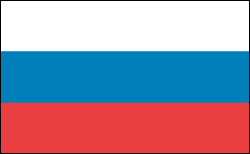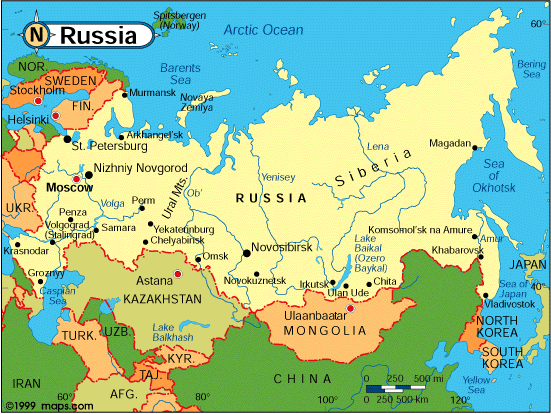RUSSIA

Geography: The Russian Federation is the largest of the 21 republics that make up the Commonwealth of Independent States. It occupies most of eastern Europe and north Asia, stretching from the Baltic Sea in the west to the Pacific Ocean in the east, and from the Arctic Ocean in the north to the Black Sea and the Caucasus in the south. It is bordered by Norway and Finland in the northwest; Estonia, Latvia, Belarus, Ukraine, Poland, and Lithuania in the west; Georgia and Azerbaijan in the southwest; and Kazakhstan, Mongolia, China, and North Korea along the southern border.
Government: Constitutional federation.
History: Tradition says the Viking Rurik came to Russia in 862 and founded the first Russian dynasty in Novgorod. The various tribes were united by the spread of Christianity in the 10th and 11th centuries; Vladimir “the Saint” was converted in 988. During the 11th century, the grand dukes of Kiev held such centralizing power as existed. In 1240, Kiev was destroyed by the Mongols, and the Russian territory was split into numerous smaller dukedoms. Early dukes of Moscow extended their dominion over other Russian cities through their office of tribute collector for the Mongols and because of Moscow's role as an administrative and trade center.
In the late 15th century, Duke Ivan III acquired Novgorod and Tver and threw off the Mongol yoke. Ivan IV—the Terrible (1533–1584), first Muscovite czar—is considered to have founded the Russian state. He crushed the power of rival princes and boyars (great landowners), but Russia remained largely medieval until the reign of Peter the Great (1689–1725), grandson of the first Romanov czar, Michael (1613–1645). Peter made extensive reforms aimed at westernization and, through his defeat of Charles XII of Sweden at the Battle of Poltava in 1709, he extended Russia's boundaries to the west. Catherine the Great (1762–1796) continued Peter's westernization program and also expanded Russian territory, acquiring the Crimea, Ukraine, and part of Poland. During the reign of Alexander I (1801–1825), Napoléon's attempt to subdue Russia was defeated (1812–1813), and new territory was gained, including Finland (1809) and Bessarabia (1812). Alexander originated the Holy Alliance, which for a time crushed Europe's rising liberal movement.
Alexander II (1855–1881) pushed Russia's borders to the Pacific and into central Asia. Serfdom was abolished in 1861, but heavy restrictions were imposed on the emancipated class. Revolutionary strikes, following Russia's defeat in the war with Japan, forced Nicholas II (1894–1917) to grant a representative national body (Duma), elected by narrowly limited suffrage. It met for the first time in 1906 but had little influence on Nicholas.
Government: Constitutional federation.
History: Tradition says the Viking Rurik came to Russia in 862 and founded the first Russian dynasty in Novgorod. The various tribes were united by the spread of Christianity in the 10th and 11th centuries; Vladimir “the Saint” was converted in 988. During the 11th century, the grand dukes of Kiev held such centralizing power as existed. In 1240, Kiev was destroyed by the Mongols, and the Russian territory was split into numerous smaller dukedoms. Early dukes of Moscow extended their dominion over other Russian cities through their office of tribute collector for the Mongols and because of Moscow's role as an administrative and trade center.
In the late 15th century, Duke Ivan III acquired Novgorod and Tver and threw off the Mongol yoke. Ivan IV—the Terrible (1533–1584), first Muscovite czar—is considered to have founded the Russian state. He crushed the power of rival princes and boyars (great landowners), but Russia remained largely medieval until the reign of Peter the Great (1689–1725), grandson of the first Romanov czar, Michael (1613–1645). Peter made extensive reforms aimed at westernization and, through his defeat of Charles XII of Sweden at the Battle of Poltava in 1709, he extended Russia's boundaries to the west. Catherine the Great (1762–1796) continued Peter's westernization program and also expanded Russian territory, acquiring the Crimea, Ukraine, and part of Poland. During the reign of Alexander I (1801–1825), Napoléon's attempt to subdue Russia was defeated (1812–1813), and new territory was gained, including Finland (1809) and Bessarabia (1812). Alexander originated the Holy Alliance, which for a time crushed Europe's rising liberal movement.
Alexander II (1855–1881) pushed Russia's borders to the Pacific and into central Asia. Serfdom was abolished in 1861, but heavy restrictions were imposed on the emancipated class. Revolutionary strikes, following Russia's defeat in the war with Japan, forced Nicholas II (1894–1917) to grant a representative national body (Duma), elected by narrowly limited suffrage. It met for the first time in 1906 but had little influence on Nicholas.

Map of Russia
President: Vladimir Putin (2012)
Prime Minister: Dmitry Medvedev (2012)
Land area: 6,592,812 sq mi (17,075,400 sq
km); total area: 6,592,735 sq mi (17,075,200 sq km)
Population (2014 est.): 142,470,272 (growth
rate: –0.03%); birth rate: 11.87/1000; infant mortality rate:
7.08/1000; life expectancy: 70.16; density per sq mi: 21.5
Capital and largest city (2011 est.):
Moscow, 11.621 million
Other large cities:
St. Petersburg, 4.866 million; Novosibirsk, 1.478 million; Yekaterinburg, 1.355 million; Nizhny Novgorod,
1.245 million; Samara, 1.166 million
Monetary unit:
Russian ruble (RUR)
National
name: Rossiyskaya Federatsiya
Languages:
Russian (official) 96.3%, Dolgang 5.3%, German 1.5%, Chechen 1%, Tatar 3%, other 10.3% (2010 est.)
Ethnicity/race:
Russian 77.7%, Tatar 3.7%, Ukrainian 1.4%, Bashkir
1.1%, Chuvash 1%, Chechen 1%, other 10.2%, unspecified 3.9% (2010)
Religions:
Russian Orthodox 15%–20%, other Christian
2%, Islam 10%–15% (2006 est.; includes practicing worshippers
only)
Literacy rate: 99.7% (2010
est.)
Economic summary: GDP/PPP
(2013 est.): $2.553 trillion; per capita $18,100. Real growth
rate: 1.3%. Inflation: 6.8%. Unemployment: 5.8%.
Arable land: 7.11%. Agriculture: grain, sugar beets,
sunflower seeds, vegetables, fruits; beef, milk. Labor force:
75.29 million; agriculture 9.7%, industry 27.8%, services 62.5% (2012
est.). Industries: complete range of mining and extractive
industries producing coal, oil, gas, chemicals, and metals; all forms
of machine building from rolling mills to high-performance aircraft
and space vehicles; defense industries including radar, missile
production, and advanced electronic components, shipbuilding; road and
rail transportation equipment; communications equipment; agricultural
machinery, tractors, and construction equipment; electric power
generating and transmitting equipment; medical and scientific
instruments; consumer durables, textiles, foodstuffs, handicrafts.
Natural resources: wide natural resource base
including major
deposits of oil, natural gas, coal, and many strategic minerals,
reserves of rare earth elements, timber; note: formidable obstacles of
climate, terrain, and distance
hinder exploitation of natural resources. Exports: $515 billion
(2013 est.): petroleum and petroleum products, natural gas, wood and
wood products, metals, chemicals, and a wide variety of civilian and
military manufactures. Imports: $341 billion
(2013 est.):
machinery, vehicles, pharmaceutical products, plastic,
semi-finished metal products, meat, fruits and nuts, optical and medical
instruments, iron, steel. Major trading partners:
Netherlands, Germany, Ukraine, Italy, China, Belarus, U.S., Switzerland,
Turkey, Japan, France (2012).
Communications: Telephones: main lines in
use: 42.9 million (2012); mobile cellular: 261.9 million (2012).
Radio broadcast stations: AM 323, FM 1,500 est., shortwave 62
(2004). Radios: 61.5 million (1997). Television broadcast
stations: 5,700 (2007). Televisions: 60.5 million (1997).
Internet Service Providers (ISPs): 14.865 million (2012).
Internet users: 40.853 million (2009).
Transportation: Railways: total: 87,157 km
(2006). Highways: total: 1,283,387 km paved: 927,721 km (includes
39,143 km of expressways) unpaved: 355,666 km note: includes public
and departmental roads (2012). Waterways: Waterways 102,000 km
(including 33,000 km with guaranteed depth) note: 72,000 km system in
European Russia links Baltic Sea, White Sea, Caspian Sea, Sea of Azov,
and Black Sea (2009). Ports and harbors:
Aleksandrovsk-Sakhalinsky, Arkhangel'sk, Astrakhan', De-Kastri,
Indigirskiy, Kaliningrad, Kandalaksha, Kazan', Khabarovsk, Kholmsk,
Krasnoyarsk, Lazarev, Mago, Mezen', Moscow, Murmansk, Nakhodka,
Nevel'sk, Novorossiysk, Onega, Petropavlovsk-Kamchatskiy, Rostov,
Shakhtersk, Saint Petersburg, Sochi, Taganrog, Tuapse, Uglegorsk,
Vanino, Vladivostok, Volgograd, Vostochnyy, Vyborg. Airports:
1,218 (2013).
International disputes:
Russia remains concerned about the smuggling of poppy derivatives from
Afghanistan through Central Asian countries; China and Russia have
demarcated the once disputed islands at the Amur and Ussuri confluence
and in the Argun River in accordance with the 2004 Agreement, ending
their centuries-long border disputes; the sovereignty dispute over the
islands of Etorofu, Kunashiri, Shikotan, and the Habomai group, known in
Japan as the "Northern Territories" and in Russia as the "Southern
Kurils," occupied by the Soviet Union in 1945, now administered by
Russia, and claimed by Japan, remains the primary sticking point to
signing a peace treaty formally ending World War II hostilities;
Russia's military support and subsequent recognition of Abkhazia and
South Ossetia independence in 2008 continue to sour relations with
Georgia; Azerbaijan, Kazakhstan, and Russia ratified Caspian seabed
delimitation treaties based on equidistance, while Iran continues to
insist on a one-fifth slice of the sea; Norway and Russia signed a
comprehensive maritime boundary agreement in 2010; various groups in
Finland advocate restoration of Karelia (Kareliya) and other areas ceded
to the Soviet Union following World War II but the Finnish Government
asserts no territorial demands; Russia and Estonia signed a technical
border agreement in May 2005, but Russia recalled its signature in June
2005 after the Estonian parliament added to its domestic ratification
act a historical preamble referencing the Soviet occupation and
Estonia's pre-war borders under the 1920 Treaty of Tartu; Russia
contends that the preamble allows Estonia to make territorial claims on
Russia in the future, while Estonian officials deny that the preamble
has any legal impact on the treaty text; Russia demands better treatment
of the Russian-speaking population in Estonia and Latvia; Lithuania and
Russia committed to demarcating their boundary in 2006 in accordance
with the land and maritime treaty ratified by Russia in May 2003 and by
Lithuania in 1999; Lithuania operates a simplified transit regime for
Russian nationals traveling from the Kaliningrad coastal exclave into
Russia, while still conforming, as an EU member state with an EU
external border, where strict Schengen border rules apply; preparations
for the demarcation delimitation of land boundary with Ukraine have
commenced; the dispute over the boundary between Russia and Ukraine
through the Kerch Strait and Sea of Azov is suspended due to the
occupation of Crimea by Russia; Kazakhstan and Russia boundary
delimitation was ratified on November 2005 and field demarcation should
commence in 2007; Russian Duma has not yet ratified 1990 Bering Sea
Maritime Boundary Agreement with the US; Denmark (Greenland) and Norway
have made submissions to the Commission on the Limits of the Continental
shelf (CLCS) and Russia is collecting additional data to augment its
2001 CLCS submission.
-------------------- o --------------------
No comments:
Post a Comment